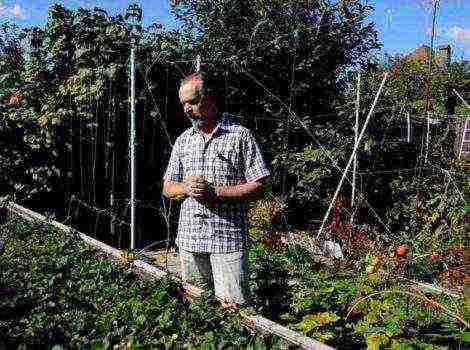Content
It is difficult to imagine a vegetable garden without strong bushes of pepper. Growing pepper in the Moscow region is an easy task. The climatic conditions of central Russia make it possible to get a good harvest in the open field. This garden culture is quite unpretentious, but it is imperative to follow the growing rules. This will help to avoid unpleasant surprises: diseases, poor growth, poor fruiting. As a reward for diligence, the table of a good gardener will be decorated with a variety of dishes in due time, and the cellar will be decorated with conservation of this healthy vegetable.

When to plant peppers for seedlings in 2018 according to the lunar calendar
- March - 6, 7
- April - 4
- May - 9, 10
Land preparation
The soil for the pepper is prepared in the fall. Unwanted predecessors are nightshade crops (tomatoes, potatoes, eggplants). In the areas of their growth, spores of destructive diseases live for 3 years. It is very useful to grow peppers in the open field in the place where pumpkin seeds, legumes, root crops, and cabbage grew last year. First of all, they choose a sunny area, protected from the wind by the wall of the house or by a fence. Pepper does not like winds and drafts, which are not uncommon in the Moscow region.
The soil for planting should be light and nutritious. In cold clay soils, any efforts made by the gardener will not give a satisfactory result. Such soils are facilitated by the addition of peat. They dig the earth deeply, apply fertilizer to it at the rate of 1 m2:
- humus or rotted manure - 5 kg;
- wood ash - 100 g;
- superphosphate - 30 g.
In the spring, the soil is again fed with phosphorus, nitrogen and potash fertilizers (30-40 g each per 1 m2) and loosened.
Seed preparation
Processing planting material is often neglected in a hurry, and in vain. The germination of treated seeds is significantly improved, and more protected plants grow from them. It is worth spending a little time to get a guaranteed good result. First, the seeds are placed in hot water (40-50˚C) for half an hour. The high temperature will relieve the pepper from fungal diseases. You can replace hot water with a dark pink solution of potassium permanganate.
The next stage provides the seeds with maximum germination: they are lowered for 12 hours in a container with a growth stimulator. And the last - spread the planting material for several days on wet gauze and leave in a warm place. Remember to dampen the fabric. As soon as the first sprouts hatch, it's time to land in the ground.
Planting seeds for seedlings
Growing pepper in the Moscow region for seedlings begins in late February - early March. We will prepare light and nutritious soil in advance. An all-purpose primer purchased from a specialist store is ideal. You can prepare the soil mixture yourself by mixing 2 parts of peat with 1 part of sand and 2 parts of humus. Fill the containers with the mixture, leaving 1.5 cm to the edge.
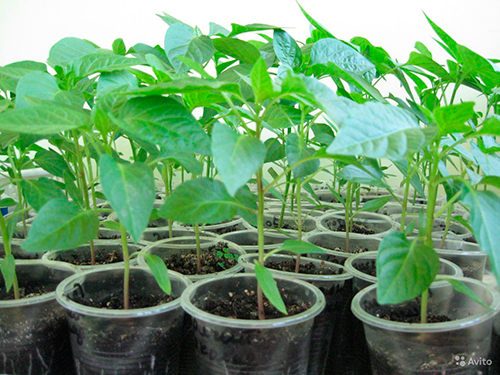
Pepper sprouts and roots are very tender and brittle, they do not tolerate a pick poorly. If the plant is damaged during transplantation, its growth will slow down. Therefore, peat pots, plastic sour cream cups, cut plastic bottles are often used as containers.The holes in the bottoms are pierced with a hot knitting needle. The soil in the pots is abundantly irrigated with a spray bottle. Place 1 - 2 seeds in each pot. Top them fall asleep with a thin layer of soil (0.5 - 1 cm).
For successful germination, the containers are kept in a warm place for two weeks, covered with foil or glass. Water the soil in pots every three days. This must be done carefully so as not to wash the seeds. The best option is to spray from a spray bottle. As soon as shoots appear on the surface, put them on a well-lit windowsill. If you skip this moment, the sprouts will stretch out, the quality of the seedlings will deteriorate.
Seedlings - cultivation and fertilization
The correct temperature regime is 50 percent success for good seedling growth. At low temperatures and abundant watering, the plant is affected by root rot. If the room is dry and hot, the earthen coma dries up and the shoots die. The cultivation of pepper in the suburbs has some peculiarities. A plant native to South America, it is very demanding on light. Place the pots on the southern windowsill, if there is a lack of light, arrange a backlight. Water them as the earthy coma dries out, keep the room temperature + 20˚С.
Top dressing is applied twice:
- Two weeks after germination - 2 liters of water, 0.5 liters of nettle infusion, 50 g of wood ash.
- After the first feeding two weeks later - for the same amount of water, 3 g of ammonium nitrate, 12 g of superphosphate, 4 g of potash fertilizers.
Transplanting
To plant seedlings in open ground in a timely manner, monitor the weather. Low air temperature inhibits plant development. In the first ten days of May, the last frosts usually occur in the middle lane. By the middle of the month, the temperature is set at around + 15˚С. Planting pepper in the Moscow region on the beds usually occurs after May 15.
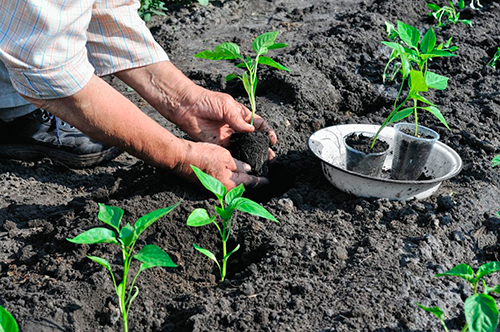
In the loosened earth, holes are made according to the scheme:
- distance between plants - 30 cm;
- the distance between the rows is 40 cm.
Holes in open ground and soil in pots with seedlings are poured with water. After complete absorption, the plants are very carefully removed together with the earth from the pots, placed in the holes, the root collar is slightly deepened - 1 - 2 cm is enough. The holes are filled up, slightly compacted. To protect from cold weather, small seedlings are closed at night with two-liter plastic bottles with cut necks.
Watering and loosening
The correct watering depends on how fruitful the cultivation of pepper in the open field will be. Plants are watered 4 days after planting on the beds, then once a week until the fruits appear. To enable the formation of a new ovary, the first crop is harvested, at which time watering is stopped.
The resumption of regular watering occurs after the appearance of re-flowering.
From overconsolidation of the soil and a lack of oxygen in it, the roots of the pepper rot and die. Be sure to loosen the ground beneath them after each irrigation, this is a good disease prevention.
When loosening, remove weeds, use them to mulch row spacings (without seeds). The ground under the plants can also be mulched. For this purpose, sawdust, straw, hay, film are used. Mulch retains moisture well, prevents soil overconsolidation.
Fertilization and shaping
A common practice among gardeners in the Moscow region is to feed pepper three times per season:
- two weeks after landing in open ground;
- during the flowering period;
- during fruit set.
For the first feeding, 50 g of superphosphate, 200 g of wood ash are dissolved in 10 liters of water.
The second feeding: 20 g of ammonium nitrate, 70 g of superphosphate and 250 g of wood ash are diluted in a bucket of water.
For the third time, pepper is fertilized at a time when it especially needs nutrients. The solution is prepared in advance, 50 g of chicken droppings or 100 g of mullein are placed in a bucket of water and insisted for a week. One bucket of each solution is used for 8 to 10 plants.
Don't forget about pinching.When the plant begins to branch out, leave the two strongest first-order shoots. Carefully cut off the rest with a knife or secateurs. When further branching these shoots, select the strongest again. All sterile shoots that will appear later, remove without regret. This procedure will help the pepper save energy for fruit development.
Features of harvesting, frost protection
To get the maximum yield, you should not wait for the fruit to fully ripen. Remove the fruits from the bushes together with the stalk when they reach technical maturity. Spread them in a single layer in a warm and dry place, they will ripen within two weeks. Plants freed from fruits will give all their strength to the development of ovaries, to new fruiting.
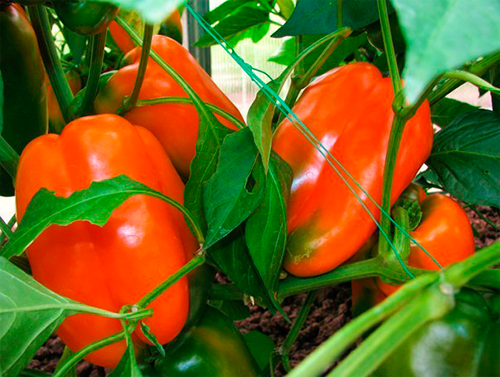
In the middle lane from the end of August, the nights are cold. By protecting plants from frost, fruiting periods are extended until mid-October. To get a fall harvest of a thermophilic South American vegetable:
- arcs are installed on the beds and covered with plastic wrap or agrofiber;
- put on each bush a perforated polyethylene bag, tied to a peg driven into the ground;
- in calm, calm weather, a proven method is used - the creation of smoke screens: heaps of dry leaves, peat, sawdust, garbage are made in free places in the garden, they are lit in the evening, and extinguished 2 hours after sunrise.
Rate the article:
Rating: 5/5 - 1 votes
Sweet pepper is a popular and widespread crop; it is grown by almost all gardeners. If the climate in the region does not allow planting a vegetable in the open field, it is sure to be allocated a comfortable place in the greenhouse, they have learned to cope with it even in Siberia.
Let's talk about how to grow sweet peppers in the open field in the Moscow region and what varieties you need to choose.
There are no special difficulties, if we take into account all the nuances, the summer in the region lasts 90 days, it is warm, relatively humid, daylight hours take from 14 to 17 hours. Temporary shelter (film) may be required only for the first time after disembarkation. With the right choice of varieties and preparation of seedlings, the vegetable manages to give up the entire crop before the beginning or middle of autumn.
Seedling growing rules
In the case of a capricious pepper, the preparation of seedlings is carried out very carefully, you should carefully study all the rules and take into account the advice of experienced gardeners. The information on the package will help to understand the timing of sowing seeds. Sweet pepper seedlings are grown as follows:
- if the seeds are sown in separate pots, 2 grains should be placed in the soil; they do not need to be buried more than 2 cm. In a wide container, the sowing pattern is as follows - in a row, seeds are placed at a distance of 1, 5 or 2 cm from each other, row spacing is not more than 3 cm, depth is 2 cm;
- immediately after sowing, the soil must be moistened with a spray bottle and the container must be covered with transparent material; before the shoots appear, the boxes are placed in a warm room (22–26 ° C during the day, 16–17 at night) and the soil is kept moist;
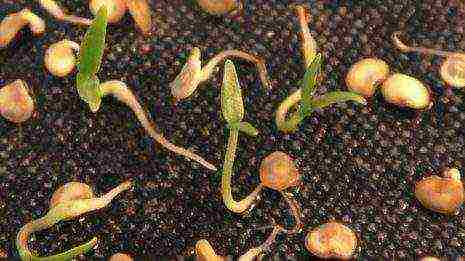
- after the emergence of seedlings, the seedlings are placed in a well-lit place, and the temperature is reduced to 16 or 18 degrees, kept in such conditions for a week. The procedure promotes the development of the root system. Then the temperature is increased to 20–25 ° C;
- the pick is carried out in phase 2 of these leaves, the temperature regime is maintained at the same level;
- seedlings are planted in open ground at the age of 40 or 60 days, overgrowth should not be allowed, the bushes will weaken and the first fruits will not appear soon. During the entire cultivation period, top dressing should be carried out (no more than 3 times), monitor soil moisture, provide plants with light from 8 to 20 hours. In no case should the temperature be lowered, the culture does not tolerate hypothermia.
Seed germination in peppers is weak, so they require pre-sowing preparation (selection and processing in growth stimulants).The soil for seedlings, if taken from the garden, must be disinfected in any convenient way. All irrigation is carried out only with warm, settled water.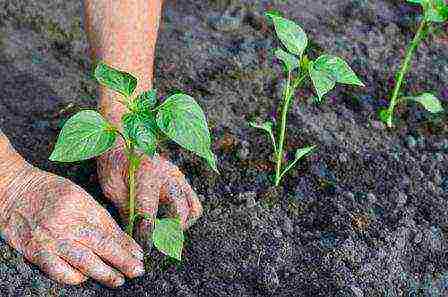
Proven varieties for open ground for the Moscow region
The growing season of early-ripening peppers takes 95-130 days, mid-ripening - 140, and late ones within 150. Taking into account the fact that summer lasts 90 days, and seedlings are planted at the age of 50-55 days, then for the Moscow Region, mid-season and early varieties are considered the best , we have selected the best, tried and tested options and share them with you.
Gingerbread man
Early ripe pepper, bush just over half a meter, compact, densely leafy. Fruits (up to 160 g) are round, slightly ribbed, flattened, burgundy. Fleshy peppers, maximum wall thickness 2 cm, juicy pulp with incredible taste and aroma, few seeds. From 1 m² you can harvest up to 8 kg. Immunity to bad weather conditions, as well as to common diseases is good. Planting density - 5 plants per 1 m².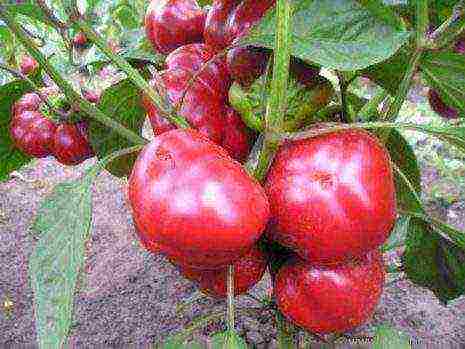
Montero
The variety is early maturing, tall (up to 120 cm). Fruits up to 350 g are juicy, very tasty, prismatic, dark red. In 2002, a record weight of pepper was recorded - almost 950 g. The thickness of the walls is about 7 mm. Montero is resistant to all negative factors, especially the tobacco mosaic virus. The yield from 1 m² (4 bushes) ranges from 7 to 13 kg.
Aries
Hybrid, early pepper up to 1.5 m in height. The fruit is prismatic, dark red up to 300 g, walls about 6 mm. Taste and appearance are excellent, immunity to fungi and viruses, especially tobacco mosaic, is good. From a square meter, with proper care, you can collect from 7 to 15 kg of pepper.
One
An early ripe hybrid, a bush no higher than 70 cm, neat. Peppers (up to 200 g) are cuboid, red, walls about 8 mm, juicy flesh, sweetish taste. Immunity to all negative factors is good. Even in bad and unstable weather, the amount of harvest per square meter remains within 3-5 kg. The bush needs a garter.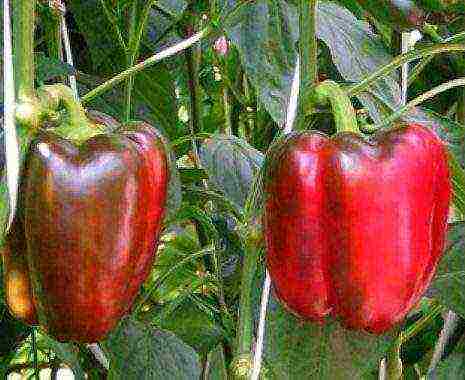
Topolin
A mid-season variety, a standard bush, neat not higher than 70 cm. Peppers (up to 150 g) are conical-elongated, red, tasty, juicy and fragrant, the walls are about 6 mm. Virus and disease resistance is excellent. Up to 15 fruits are tied on one bush, the fruiting period is prolonged, the yield is high, a garter is needed.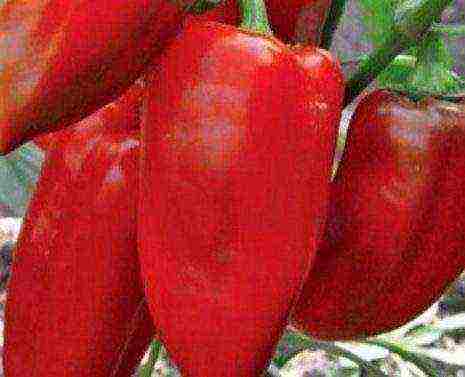
Mercury
Hybrid of early ripening, bush no higher than 1.5 m with short internodes, weakly branched, spreading, but compact enough. Fruits (200–250 g) are juicy and tasty, red, conical, walls about 7 mm. The maximum yield per square meter is 12.5 kg, the resistance to the tobacco mosaic virus is excellent.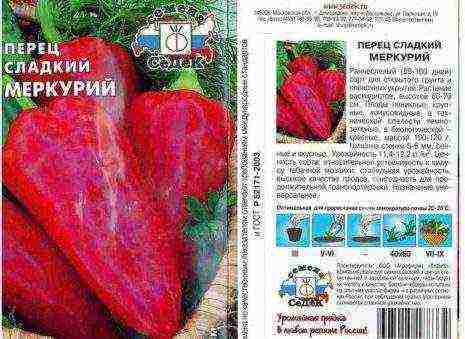
Victoria
An early variety, a bush just over half a meter, medium spreading, standard. Peppers are red, conical, slightly ribbed up to 70 g, walls about 8 mm. Taste and commercial qualities are at a high level. Cold hardy variety with excellent immunity to the most common diseases. The maximum yield from 1 m² is 7 kg of pepper.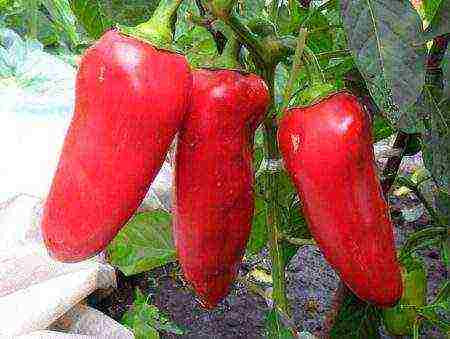
Gift from Moldova
A mid-season variety (known since 1973), a bush with short internodes no higher than half a meter, half-stem. Peppers up to 170 g are cone-shaped, red, walls are about 7 mm, very tasty and juicy. The plant requires shaping (the lower shoots are removed before the first fork) and a garter. The variety has excellent immunity to all negative factors, it is particularly unpretentious. The amount of harvest per square meter ranges from 5 to 9 kg.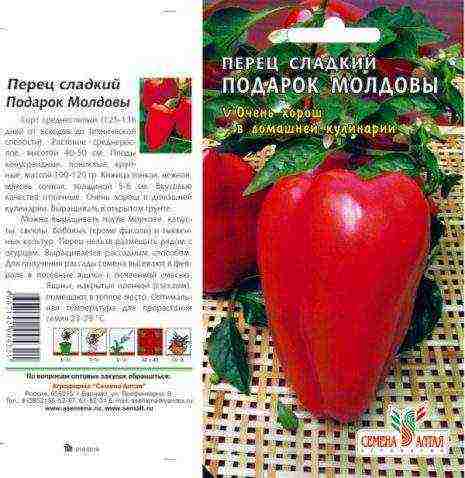
You may be interested in:
Dobrynya
Pepper ripens in medium terms, the bush is medium-sized, neat, densely leafy. Fruits (up to 110 g) are prismatic, dark red, walls are 4 or 5 mm, the taste is very pleasant. The yield of Dobrynya pepper is 11–14.5 kg per 1 m². The variety is resistant to the tobacco mosaic virus and fusarium, but the immunity to the top rot is average.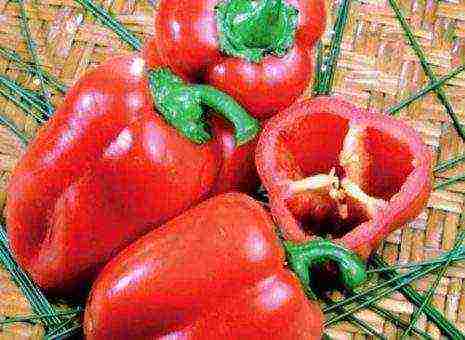
Gogoshary
Mid-season variety, other names are Ratunda and Mini Gogoshar. Fruits (up to 130 g) are round, flattened, ribbed, red, walls from 5 to 8 mm.Standard bush, spreading just over half a meter. The appearance of the fruit is excellent, the taste of the pulp is sweet, and the partitions are pointed. Disease and pest immunity is good.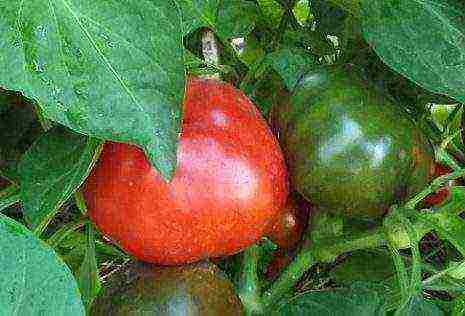
Atlantic
An early ripe hybrid, a powerful plant, densely leafy just above 95 cm. Sweet peppers, elongated-cuboid, 4-chambered, red up to 410 g, walls about 1 cm. Atlantic pepper is high-yielding, resistant to tobacco and potato mosaic viruses.
Golden Taurus
Mid-early hybrid, plant height - 90 cm. Peppers up to 510 g are sweet, yellow-orange, fleshy (walls about 10 mm), cuboid. Ripening is amicable, quite a lot of fruits are formed on one bush - from 15 to 25 pieces, the plant does not always support their weight, a garter is required. Immunity to fungi and viruses is excellent.
Pepper care
You can plant peppers in open ground when return frosts have passed and the soil warms up well. The land is prepared in autumn, ash, humus, complex fertilizers and bird droppings are introduced for digging. The soil should be fertile, non-acidic, light and loose. The bush is buried on the first true leaf, the soil is mulched. Depending on the characteristics of the variety (bush habit), 3 to 5 plants are planted per 1 m².
For the entire time of growing the culture, the soil must be carefully loosened (the roots are located close to the surface of the earth), weeds must be removed, the bushes can be spud a little. Tall varieties need to provide support for the garters.
Correct feeding
The first feeding is carried out after the plants take root in a new place and begin to grow, about 2 weeks after planting, bird droppings or superphosphate are suitable. The second procedure is carried out during mass flowering and the appearance of the first ovaries (infusions of droppings or weeds, mineral complexes). The last fertilization session falls on the fruiting period, you can use calcium nitrate.
Correct temperature
The average daily summer temperature in the Moscow region ranges from 16–20 ° C, this is an average, usually slightly higher. Pepper is a heat-loving vegetable, the temperature of 20-25 degrees is considered optimal for its cultivation. Lowering the temperature regime will affect the leaves, they will acquire dark spots or acquire a lilac hue. The critical temperature dangerous for peppers is 13-15 ° C, during such periods plants should be hidden under a film cover.
Proper watering
For the first 10 days, the planted seedlings are watered every day, in moderation and only with warm water. In the future, in normal weather, watering is carried out 2 times in 7 days, in heat and drought more often. Drying out will lead to the fact that the bushes will shed their foliage and ovaries, and excessive moisture threatens root decay or the development of fungal diseases.
The cultivation of sweet peppers in unprotected soil on land plots near Moscow requires special attention. The plant needs to be provided with good conditions and constantly looked after. But pepper lovers are not afraid of any difficulties and try to do everything possible to get a good harvest of their favorite vegetable, even in adverse conditions.
Reviews
Vadim. We used to live in the south, not so long ago we moved to the Moscow region, that I knew the capricious pepper and took the seeds of universal varieties, then little by little I began to find other options suitable for my region. What can I say, my peppers do not get sick at all, the yield is consistently high, the main thing is to follow the rules of cultivation and not lose sight of the peculiarities of the climate.
Ekaterina. The dacha is located in the suburbs, I always have a good harvest of pepper, I grow it in the open field. Even before landing, just in case, I install a frame for the film, I still have to cover the landings, but very rarely. To be sure that diseases will definitely not appear, I follow the rules of cultivation, and I carry out preventive spraying against pests.
In the middle lane, the favorable time in the open field for pepper is a little more than two months.However, there are ways to "expand" these narrow natural boundaries in order to get an excellent harvest.
Landing in the ground: optimal timing
The optimal time for planting pepper seedlings in the garden in the middle lane is May 15. Previously, it rarely happens because of the repeated late spring cold snap, which usually happens in our country on May 1–5 and 10–14. The third time it can come at the very end of the month. But it is too late to plant peppers in early June - the plants do not have time to give up their entire potential harvest until August 10, when the night temperature drops sharply in the Moscow region and the intense fruiting of heat-loving sissies stops.

Shelter
For pepper seedlings, it is necessary to provide for an acceptable temperature: from + 15 ° С and above (optimal + 18 ... + 25 ° С), because already at + 13 ° С its development stops. And if the temperature is not raised within 5 days, growth will stop for 3 weeks even after warming!
I didn't have a greenhouse, and I didn't have a place for it - the site is occupied by an orchard, a flower garden, buildings. On the other hand, it turned out to be a free space adjoining the capital brick fence on the south side. It is slightly raised, it is well warmed by the sun from morning to evening. Such a place is ideal for a lean-to greenhouse of the simplest design, which allows you to maintain a much higher temperature inside than in an open space without any special problems and costs.
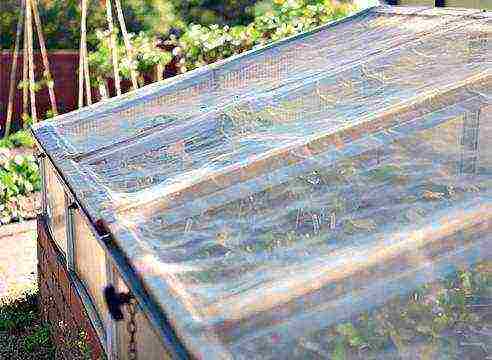
To do this, at a height of one and a half meters, I screwed a long 6-meter block on screws close to the brickwork, strictly horizontally. I put the same one on the ground a meter away from the fence. To them with nails at the top and bottom, every 40-50 cm, nailed transverse slats (at an inclination of about 60 degrees). The result is a compact frame on which the film is easily stretched. However, I did not limit myself to a single-layer shelter, having arranged a second - very low - greenhouse literally 50 cm from the ground, inside the first one. And laid a thick mulch film on the surface of the soil.
Frameless reliable shelters made of agrotextile could also be used. As the manufacturers assure, they maintain a sufficiently high above-zero temperature even during frosts. Finally, the bushes planted directly on the garden bed, while they are not tall, can be covered with ordinary two-liter plastic bottles turned upside down with a cut-off neck, and also five-liter bottles on top. For better warming, not a flat surface is desirable, but a high bed with loose fertile loamy soil and a generous addition of manure or compost.
Landing
Seedlings from cups are planted carefully, completely preserving the earthen lump and deepening the root collar by 1–2 cm, watering abundantly.
I placed my seedlings along the greenhouse in one row with a distance between plants of 40 cm, at first it was even too spacious. But in the second half of summer, when the peppers grew, they did not thicken and did not shade each other, which means that they were illuminated as much as possible by the sun, which provided a generous increase in the yield.
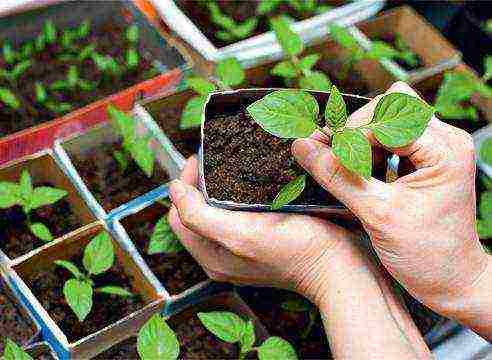
Care and feeding
The shelter is removed in the second decade of June, after warm nights are established. Nevertheless, carefully monitor the air temperature and, if necessary, re-insulate the seedlings. Indeed, with a decrease in temperature during the day to + 16 ... + 18 ° C, the timing of flowering and fruit setting is postponed for several days.
In a more or less favorable summer, I leave the pepper open until August 10, right up to cold nights, when I again cover the greenhouse with a film or non-woven material - one layer is enough. Indeed, at the end of summer, adult pepper bushes normally tolerate a drop in temperature and, unlike tomatoes, are less likely to get sick. But during the entire growing season, peppers react poorly to soil compaction and lack of oxygen in it, which is why the roots often die off. Therefore, after each watering, it is necessary to destroy the soil crust by loosening.Unless, of course, you have not previously mulched the surface of the earth with film, peat or sawdust - they retain moisture for a long time, watering does not lead to overconsolidation, and they are then required much less often.
With mass flowering, setting and pouring of fruits, sweet peppers are especially demanding on nutrition, therefore, from June to early August, it is advisable to feed it once every 2 weeks with weak solutions of organic and complex mineral fertilizers, alternating them. For example, Radogor, Bucephalus, Flumb! - with "Sudarushka" or "Fertika". And in cool months (in May and during August) foliar nutrition is effective - spraying the leaves with a 0.5% solution of the same "mineral water", as well as sodium humate.
Formation
It is not always required - only when some varieties thicken. I periodically carefully review my plants (with single-row placement, this is not difficult). I leave no more than three strong shoots on each, pluck the rest at the initial stages. And so that, before the stable September frosts, the already set fruits will fill up and have time to ripen, on August 5-10, I cut off the tops of all the bushes - then the process is noticeably accelerated.
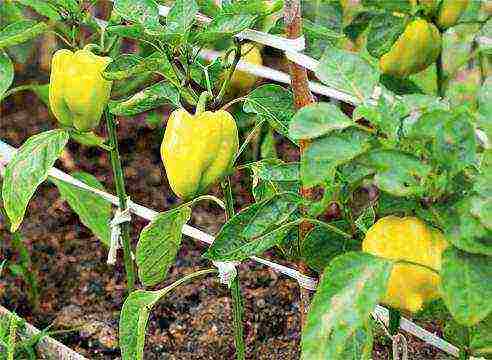
With such a care, and in the middle lane, you can collect sweet, tasty peppers from late June to September every week. And if you cut them at the stage of technical ripeness (green), without waiting for biological - until they become colored (red, yellow, etc.) - then the yield practically doubles, reaching by the end of the season 8-10 kg of large wonderful fruits from each square meter ...
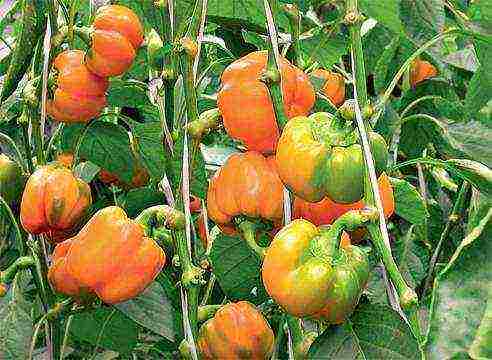

What to do, if…
... you bought the fruits of a very tasty pepper on the market and want to grow it at home?
Pepper is a self-pollinated plant, you can try to grow your favorite variety from the seeds of the purchased fruit. But treat it like an experiment that may or may not be successful. First, you will only get cultivars if you actually bought a cultivar and not an F1 hybrid. Anything will grow from the seeds of a hybrid plant, just not the beautiful, sweet fruits that you tasted. Second, even if it is a cultivar, it may be too thermophilic for your garden. But you should definitely try to sow a few seeds - what if you're lucky?
… Pepper seedlings turn yellow and leaves fall?
This is possible if the plants are in a draft, or the air is very dry, or the roots are waterlogged. Place the seedling pots on a stand (such as a piece of styrofoam) to keep the soil in the pot from cooling. Start spraying the seedlings and go to watering 2 times a day, but in small portions (so that the soil in the pot does not "chomp" after watering).
... in hot weather the pepper plants have stopped growing, the upper leaves become smaller, and the lower ones wither?
Probably, these are the first symptoms of verticillary wilting - a fungal disease of pepper. It is activated in hot weather when the soil around the plants overheats. Stop watering during the day, try to water the pepper in the morning. Mulch the soil with compost to avoid the death of the root collar tissue from contact with its heated surface. As a rule, if conditions are adjusted in time, the plants will recover.
Bell peppers are among the vegetables that must be grown in any vegetable garden. Despite the southern origin and delicate nature of this vegetable, they learned to manage it even in the Siberian regions of the motherland. Growing any kind of sweet pepper for the Moscow region is not considered a difficult process, despite the fact that this vegetable does not grow naturally in our country. The main attention should be paid to the correct choice of a suitable variety.

Requirements for growth conditions
The climatic conditions in the Moscow region are quite suitable for growing peppers. The average daily temperature of a 90-day summer ranges from + 16-20 ̊С, the air humidity is 76%, the length of the day is from 14 to 17 light hours.This allows peppers to be grown under a temporary film cover.
The biological characteristics of the growth of peppers require compliance with the following conditions for normal growth:
- high above zero temperatures during the entire growing period from +20 ̊С to 27 С;
- sufficient watering, the roots are located no deeper than 20-30 cm;
- daylight hours at least 12 hours;
- nutritious soil and sufficient fertilizer;
- loosening and removing weeds.
The growing season for peppers is quite long. It lasts from 95 days for ultra early ripening varieties to 150 for late varieties. If we consider that pepper seedlings are planted at 60 days of age, and summer lasts 90 days, then medium varieties with a growing season of no more than 140 days are suitable for the Moscow region.
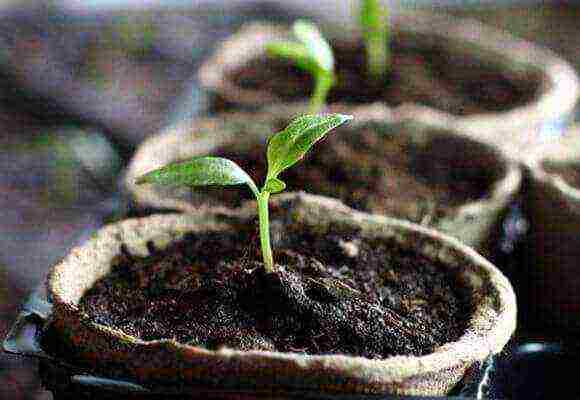
The State Register lists 743 varieties of sweet peppers, many of which are suitable for cultivation in all regions of the country. There are only 11 items later, three of which were included in the Register only in 2017. Half of the varieties presented are hybrids. With optimal growing conditions, which are usually found in a greenhouse, hybrids are capable of producing huge yields.
The breeders of Russia made sure that the peppers give a reliable harvest in unfavorable natural conditions, that they tolerate temperature drops and changes well, and low illumination.
In addition to adapting to an unstable and unsuitable climate, breeders sought to create vegetables with fruits of different sizes, colors, shapes, tastes and aromas, wall thickness, and quality. Peppers are divided into universal, salad and bred for processing and canning.
The yield is very different - from 1 to 10 kg per 1 sq. m. The early ones are more productive than the later ones. Mid-season peppers keep better than early peppers. They are suitable for long-term transportation. Be sure to choose fruits with juicy and thick walls 5-6 mm wide.
Varieties for the Moscow region
The main rule when growing capricious vegetables, whose homeland is in areas with a different climate, is to choose zoned varieties. They are adapted to the environment of a certain area, are resistant to local diseases, bred taking into account the main types of soil.
You can find out the name of such varieties on the website of the State Register of Plants of the Russian Federation or at the local seed station, where seeds are checked for germination or infection.
For growing pepper in the open field in the Moscow region, they choose early and medium periods, the late ones do not have time to fully mature.
Choosing varieties for growing in the Moscow region is not a problem. More than half of those registered in the State Register are suitable for growing in all regions. The varieties bred for cultivation exclusively in the Moscow region, in the Central region, are all intended for cultivation in greenhouses.
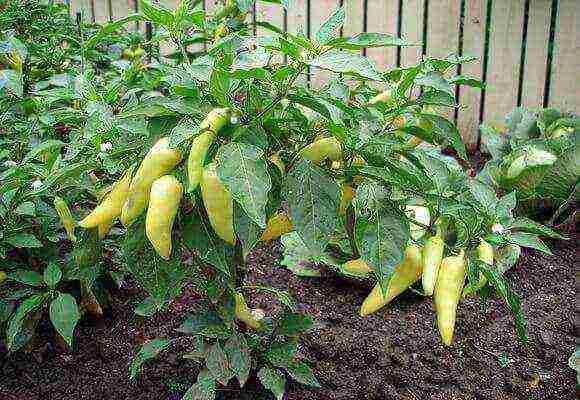
If there is no greenhouse on the site, then you need to carefully choose varieties that grow in the conditions of the Moscow region under a temporary cover made of film. These include the following peppers:
- Watercolor - early ripening, fruits of dark red color with an average weight of 30 grams, high quality, yield 3-6 kg / sq. m., can be grown in the room and on the balcony.
- Alesya is an early-ripening variety with rich red fruits, an average weight of 180 grams, with a subdued taste and a yield of 8.5 kg / sq. m.
- Admiral Ushakov F1 - refers to late-ripening varieties with dark red fruits, an average weight of 250 grams of the best quality, yield 6.9 kg / sq. m.
- Albatross F1 is a mid-early variety, rich red fruits weighing 90 grams of excellent taste, with a yield of 8.1 kg / sq. m.
- Badminton is a mid-ripe, ripe fruit of light red color, the average weight is 130 grams, the yield is 5.3 kg / sq. m.
- Barchuk is an early ripe tomato with dark red fruits, weighing 140 grams of excellent taste, yield 5 kg / sq. m.
- Belladonna - early ripe, bright, sun-saturated yellow fruits with an average weight of 130 grams, yield 4.5 kg / sq. m.
- Gift of Altai - mid-season with red tomatoes weighing 230 grams of excellent quality, yield 6.1 kg / sq. m.
- Santa Claus is an early ripe variety with dark red fruits, the average weight of which is 110 grams, yield 8.2 kg / sq. m.
- Yellow Bell - late ripening, yellow tomatoes weighing 150 grams of excellent quality, yield 8.0 kg / sq. m.
- Green miracle - mid-season, red tomatoes weighing 120 grams with good taste, yield 8 kg / sq. m.
- The lemon miracle is early ripe, the fruits are dark yellow in color, their average weight is 120 grams of good taste, the yield is 4.2 kg / sq. m.
- Black horse - early ripe, dark red fruits weighing 150-230 grams of excellent taste, yield 7 kg / sq. m.
- Chocolate round dance - mid-season, brown fruits weighing 30 grams of excellent taste, yield 5.5 kg / sq. m.
- Yaroslav - medium early, yellow fruits weighing 100 grams of good taste, yield 2.1 kg / sq. m.
An interesting series "Star of the East", developed by LLC "Agrofirm" Sedek "". The State Register includes eight early-maturing varieties of different colors: dark red, dark yellow, dark orange. The peppers of this series weigh from 150 to 230 grams with a yield of 6 to 8 kg / sq. m. The masterpiece of the series is the "Star of the East Chocolate". Its peppers weigh up to 350 grams, and the yield is up to 10 kg / sq. m.
All of the listed varieties are suitable for planting in open ground under a film shelter in the Moscow region. Productivity is indicated when grown in unheated film greenhouses or other shelters.
Before buying a vending variety, do not be lazy to find information about it in the State Register of the Russian Federation. Many councils are guilty of bad faith when they describe the advantages of varieties for indoor or not intended for planting in the Moscow region.
Agricultural technology of cultivation
Due to the extended growing season, peppers are grown through seedlings. Planting of pepper begins in February-March. The seeds are sown directly into cells or peat tablets, so as not to injure the roots during transplantation. Before germination, it is necessary to provide a temperature of + 22-26 ̊С.
After the emergence of seedlings, the temperature is lowered to + 16-18 ̊С in order to form strong roots. After a week, the temperature should be raised again to + 20-25 ̊С. And then, until the end of the growing season, it is necessary to create a temperature not lower than +20 ̊С.
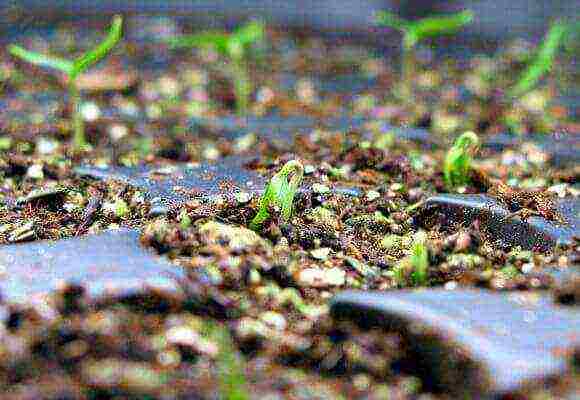
To obtain strong seedlings, plants must be provided with:
- high fever;
- adequate lighting;
- nutritious soil and top dressing;
- correct watering.
Pepper seedlings are planted in open ground at the age of 40-60 days. The overgrowth of seedlings should not be allowed when its roots become very cramped in the cell. The development of the plant is delayed, and the harvest time is postponed.
The onset of a stable positive temperature is a signal for when to plant seedlings in the beds. You should be aware that some varieties can grow outdoors, and some only in a greenhouse.
When planting seedlings in the ground, you need to monitor the temperature. At a temperature of + 15 ̊С, the development of the plant stops, at temperatures above + 40 ̊С, the roots of the plant die off due to overheating.
Important! If the pepper is cold, then the bottom of the leaves will take on a purple hue.
It is necessary to plant seedlings in the prepared soil. Even in the fall, the garden must be dug up, weeds removed and fertilized:
- ash;
- humus;
- litter;
- mineral fertilizers.
The best soils are rich in humus, light and loose.
The first ten days after transplanting into the ground, it is watered daily with warm water. You can water and cover the bed with black plastic wrap to keep the water from evaporating quickly. But in this case, the earth must be loose and moisture-permeable. Pepper can quickly die from stagnant water at the roots.

In the future, it is worth watering at least 2 times a week. The soil under this crop must not be allowed to completely dry out. The moisture content of the soil under the plant must be constantly at least 80%. In dry ground, pepper sheds flowers and ovaries.
Important! Cold water can cause root rot in plants.
This is a self-pollinating plant and does not need insects for pollination of flowers. Therefore, the yield will be excellent both when planted in open ground and when planted in a closed greenhouse. However, in case of mass flowering, it is worth shaking the bushes slightly to increase the amount of ovary.
- The first feeding of seedlings should be done after rooting and the beginning of growth. At this time, the plants need complete fertilization. A solution of bird droppings or superphosphate is suitable.
- The second feeding should be carried out during the period of mass flowering. From natural fertilizers, again, an infusion of droppings or weeds is suitable, from mineral fertilizers - kalimagnesia or Kemira-Lux.
- The third feeding is done during the fruiting period. At this time, it is important to provide plants with calcium for enhanced fruit formation. Calcium nitrate is chosen from mineral fertilizers.
The land in the garden must be weeded and loosened. Plants are desirable to slightly huddle. In the ground, additional roots grow from the stem, which increases the feeding area and the rate of ripening of the crop.
The formation of a bush and pinching is not required. Only high grades should be tied to the pegs.
Important! You cannot plant sweet and hot peppers next to it. Due to pollination, bitter peppers can be obtained on all plants.
Peppers are sick mainly with fungal diseases. It is difficult to cure them, it is necessary to use chemicals. Usually diseased plants are simply removed. To prevent diseases, it is necessary to observe the optimal growing conditions and observe the crop rotation of plants.
Harvest before full technical ripeness. Peppers ripen well after harvest. Mature ones immediately eat, they almost do not lie. At the stage of technical ripeness, they are perfectly stored for a month at room temperature and for several months in the refrigerator.
At the same time, they gradually acquire their final color, taste and aroma. The fruit should be removed with the stalk and stored in open plastic bags in a cool place.
Conclusion
Many vegetables have a pleasant, but lackluster taste. The aroma and taste of pepper is bright and memorable. It is simply impossible not to love him. In addition to its expressive taste and smell, pepper has numerous medicinal properties, strengthening and revitalizing the body. Along with tomatoes and eggplants, he enriched the diet and extended the human life. For this it is worth saying to him: "Thank you, pepper!".
